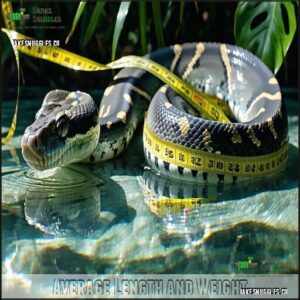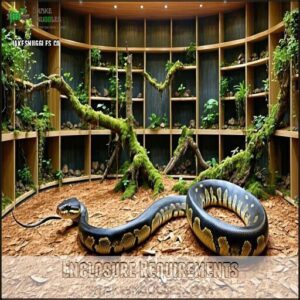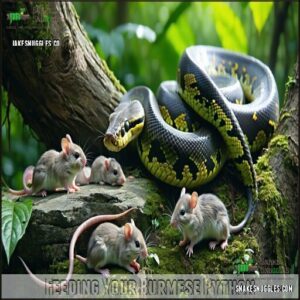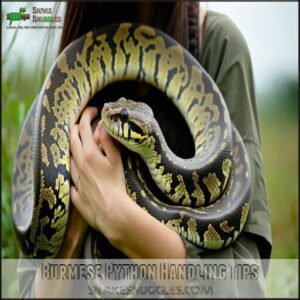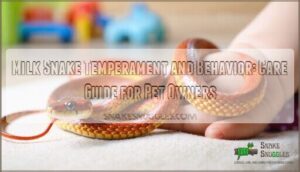This site is supported by our readers. We may earn a commission, at no cost to you, if you purchase through links.
 A Burmese python demands serious commitment, starting with a spacious enclosure—minimum 8x4x4 feet for adults—with sturdy locks (because these escape artists love adventures).
A Burmese python demands serious commitment, starting with a spacious enclosure—minimum 8x4x4 feet for adults—with sturdy locks (because these escape artists love adventures).
Maintain a temperature gradient of 83-88°F and around 60% humidity; a big water bowl helps with hydration and sheds.
Feed juveniles appropriately sized prey every 5-7 days, scaling up to larger meals every 1-2 weeks for adults.
Always support the snake’s full body when handling—no one likes feeling like they’re falling.
Monitor their health for issues like inclusion body disease or respiratory infections, as early detection is key.
Ready for more insights? Your python’s success starts here.
Table Of Contents
- Key Takeaways
- Burmese Python Size and Habitat
- Burmese Python Heating and Lighting
- Feeding Your Burmese Python
- Burmese Python Handling Tips
- Burmese Python Health Issues
- Frequently Asked Questions (FAQs)
- What signs of shedding should I look out for with my Burmese python?
- Are Burmese pythons legal to own where I live?
- How often should the enclosure be cleaned?
- Can Burmese pythons be housed with other snakes?
- What are signs of stress in Burmese pythons?
- Do Burmese pythons require UVB lighting or supplements?
- How do you safely transport a Burmese python?
- Conclusion
Key Takeaways
- Keep your Burmese python in a secure enclosure that’s at least 8x4x4 ft, with proper temperature gradients (90-92°F for basking, 78-82°F at night) and 60% humidity.
- Feed appropriately sized prey like mice, rats, or rabbits based on your python’s age, every 5-7 days for juveniles and every 1-2 weeks for adults.
- Handle your python calmly, supporting its entire body to avoid stress and injury, and avoid sudden movements to build trust.
- Watch for signs of health issues like respiratory infections or Inclusion Body Disease; early detection and proper veterinary care are critical.
Burmese Python Size and Habitat
When you bring a Burmese python home, you’re welcoming a massive snake that can grow over 16 feet long and weigh up to 250 pounds, requiring a seriously large and secure living space.
Bringing home a Burmese python means committing to a giant, awe-inspiring snake that needs a secure, spacious habitat to thrive.
Understanding their habitat needs is paramount, as these giant constrictors demand a carefully designed enclosure that mimics their native tropical environments, with precise temperature and humidity controls to keep them healthy and thriving.
Average Length and Weight
Measuring the massive Burmese python reveals fascinating size dynamics that’ll make any reptile enthusiast’s jaw drop. These incredible serpents showcase remarkable growth characteristics:
- Average captive length: 11-12 feet
- Females substantially outweigh males
- Rapid initial growth pattern
- Slowing expansion after 10 feet
- Sexual dimorphism prominent in weight
Wild pythons can stretch beyond expectations, but captive environments typically moderate their growth rate.
Understanding these size nuances helps snake keepers provide suitable care for their scaly companions. It’s worth noting that dwarf varieties exist, exhibiting considerably smaller adult sizes. Weight fluctuation depends on nutrition, habitat, and individual genetic factors.
Understanding these size nuances helps snake keepers provide suitable care for their scaly companions.
Enclosure Requirements
When designing a python enclosure, think of it as creating a five-star hotel for your massive reptilian roommate.
Your snake’s sanctuary must be sturdy, escape-proof, and spacious enough to accommodate its impressive size.
Here’s your blueprint for python paradise:
- Choose an enclosure at least 8′ long with a sturdy, locking lid to prevent any Houdini-style escapes.
- Select moisture-retaining substrate like cypress mulch to maintain prime humidity levels.
- Install sturdy climbing structures—branches, ropes, or shelves—that can support your snake’s substantial weight.
This setup guarantees your Burmese python feels secure, comfortable, and mentally stimulated.
Many owners find pre-built enclosure options convenient.
Burmese Python Heating and Lighting
You’ll need to master precise heating and lighting techniques to keep your Burmese python thriving in captivity.
Your snake’s health depends on creating a carefully controlled environment that mimics its native tropical habitat, complete with strategic temperature gradients and appropriate light cycles.
This environment is crucial for the snake’s well-being, and strategic temperature gradients play a significant role in maintaining its health.
Temperature Range
Keeping your Burmese python cozy relies on precise temperature control.
Create a thermal gradient: basking spot at 90-92°F, cooler areas 78-82°F at night.
A thermostat secures accurate regulation.
Maintain 50-60% humidity for shedding success, with a large water bowl for hydration.
Proper husbandry includes replicating natural conditions to secure peak health.
Seasonal adjustments help mimic nature’s rhythm, keeping your snake content.
Follow this guide, and your snake’s comfort will soar—literally and figuratively.
| Temperature Setting | Range (°F) | Purpose |
|---|---|---|
| Basking Spot | 90-92°F | Digestive health, activity |
| Daytime Gradient | 85-90°F | Temperature regulation |
| Night Temperatures | 78-82°F | Rest and energy balance |
Heating Options
Heating your Burmese python’s enclosure isn’t just about warmth—it’s about replicating nature. Proper temperature control supports good health and behavior.
Use thermostats with safe heating options like:
- Heat pads: Reliable, even warmth for smaller spaces.
- Ceramic heaters: Great for gentle, all-day heating without light.
- Heat lamps or basking bulbs: Ideal for creating warmer basking spots.
- Heat tape: Flexible solutions for larger setups.
Maintain temperature gradients (83-88°F) for thermoregulation and humidity around 60%.
Many owners buy supplemental heat sources for their enclosures.
Avoid burns by placing equipment securely—your snake’s comfort guarantees a happy, healthy companion!
Feeding Your Burmese Python
Feeding your Burmese python isn’t complicated, but you’ll need to match the prey size to your snake’s growth stage.
Stick to a consistent feeding schedule, and your python will thrive on healthy, appropriately sized meals.
Prey Size
Matching your python’s meals to its size is key to a healthy diet and proper digestion.
Hatchlings thrive on rodents like mice, while juveniles can handle rats. As they grow, subadults progress to rabbits or ducks, and giant adults may manage occasional goats.
Always choose prey close to the python’s widest body section to avoid digestion issues or obesity.
Switching to frozen prey reduces parasite risks, and maintaining proper prey variety guarantees first-rate nutrition.
Selecting the correct appropriate prey size is essential for successful feeding.
Feeding Frequency
If you want your Burmese python to thrive, tailoring its feeding frequency is key.
Juveniles often have a voracious appetite—feed them small meals every 5–7 days.
Adults, however, need larger prey every 1–2 weeks.
Keep them healthy by adjusting meal size and preventing obesity or regurgitation.
As opportunistic feeders, they consume whatever prey is available.
- Juveniles: Rapid growth demands regular meals with proper prey size.
- Adults: Space feedings to match their slower metabolism and size.
Burmese Python Handling Tips
Handling a Burmese python safely means supporting its body fully to reduce stress. Be calm and avoid sudden movements to keep the snake comfortable and responsive.
Support Body When Holding
Supporting your Burmese python’s body properly isn’t just smart—it’s about snake safety and mutual comfort.
Support your Burmese python fully when handling—it builds trust, ensures safety, and keeps both you and the snake comfortable.
Always use both hands: one near its head, the other supporting its midsection or tail.
Improper grips can lead to stress or even injury, so remember, snakes aren’t fans of dangling!
Here’s how to master safe handling:
- Support the body fully to avoid strain.
- Use a calm, steady approach to relax your python.
- Avoid jerky motions; they can make your snake nervous.
- Keep handling periods short, around 10-15 minutes, especially early on.
Safe, steady holding reinforces trust and snake comfort with every session.
Avoid Sudden Movements
When handling your Burmese python, slow and steady wins the race.
Sudden movements can startle the snake, disrupting snake safety and making handling stressful.
Create a calm environment with a gradual approach and predictable movement.
Your python will feel secure, and you’ll build trust over time.
It’s about mutual respect—no snake enjoys surprises, and neither should you during reptile handling.
Burmese Python Health Issues
You’ll need to stay alert for potential health problems like respiratory infections and Inclusion Body Disease, which can seriously impact your python’s wellbeing.
Catching issues early, with proper care and a veterinarian’s help, keeps your snake happy and thriving.
Inclusion Body Disease
While Burmese pythons are fascinating pets, inclusion body disease (IBD) is a serious threat to their health.
This highly contagious condition spreads through shared enclosures, handling tools, and even your hands. Symptoms may appear subtly but progress quickly, warranting immediate veterinary attention.
Unfortunately, there’s no cure yet, so prevention is key. Consequently, diagnosed snakes often require euthanasia to prevent suffering.
- Quarantine new snakes for 3 months before introducing them.
- Use separate tools and enclosures for each snake.
- Wash your hands thoroughly between handling.
Stay vigilant to protect your snake!
Respiratory Infections
If your python whistles more than a kettle, it might’ve respiratory infections (RI), a common snake health issue.
Symptoms like open-mouth breathing, wheezing, or lethargy shouldn’t be ignored.
First, check humidity levels—it should stay between 50-60%.
Boost reptile health by maintaining proper snake care, like daily water changes and a clean enclosure.
Prevention methods also include keeping temperatures steady.
A vet visit is paramount for proper diagnostics, like X-rays or cultures, to pinpoint the cause.
Treatment options may involve antibiotics, antifungal medications, or even fluid therapy.
Recognizing nasal discharge indicates a potential infection.
Always prioritize professional veterinary care, as untreated snake respiratory infections can worsen quickly, undermining both your pet’s comfort and overall health.
Frequently Asked Questions (FAQs)
What signs of shedding should I look out for with my Burmese python?
Your python’s eyes will turn cloudy or blue, and its skin may appear dull or faded.
It might also become less active and refuse food.
After shedding, its colors will brighten noticeably. After shedding
Are Burmese pythons legal to own where I live?
To determine if you can legally own a Burmese python, check local state, city, or country-specific wildlife laws.
Rules vary, and some places require permits or outright ban them due to their size and invasive potential.
How often should the enclosure be cleaned?
Think of cleaning as hitting the reset button—spot-clean daily for waste, weekly for substrate refresh, and monthly for deep-cleaning the enclosure.
It keeps things sanitary and helps your python thrive.
Don’t skip it!
Can Burmese pythons be housed with other snakes?
It’s risky to house them with other snakes.
Size differences, competition for space, or stress can lead to aggression or harm.
These solitary snakes thrive best alone in their own secure, spacious environment. **
What are signs of stress in Burmese pythons?
When your snake seems like a coiled spring ready to snap, it’s likely stressed.
Look for rapid breathing, hissing, refusal to eat, striking, or excessive hiding.
Guarantee proper enclosure, handling, and environmental care.
Do Burmese pythons require UVB lighting or supplements?
Burmese pythons don’t need UVB lighting but benefit from it.
UVB helps with vitamin D production, immunity, and overall health.
If skipped, supplement vitamins D3 and calcium for their diet to avoid health issues.
How do you safely transport a Burmese python?
Use a secure, ventilated container like a snake bag or plastic tub with locking lids.
Keep it dark to reduce stress, avoid sharp movements, and monitor temperature for comfort.
Handle gently but confidently.
Conclusion
Did you know Burmese pythons can grow over 18 feet long?
Owning one means you’re committing to proper care for a true giant.
With the right habitat setup, heating, and humidity, your python will thrive.
Feed appropriately sized prey on schedule, and handle them gently, always supporting their body.
Stay alert for health issues like respiratory infections.
With dedication to this Burmese python care sheet, you’ll guarantee a healthy, happy snake that’s as impressive as it’s majestic.
Proper care for a true giant.
- https://www.facebook.com/groups/398591071129358
- https://www.reptilebasics.com/arcadia-forest-6-uvb/arcadia-d3-6-uvb-t5-bulb-46/
- https://pubmed.ncbi.nlm.nih.gov/27938703/
- https://vet.purdue.edu/hospital/small-animal/primary-care/documents/InclusionBodyDiseaseinBoasandPythons.pdf
- https://www.merckvetmanual.com/exotic-and-laboratory-animals/reptiles/viral-diseases-of-reptiles

